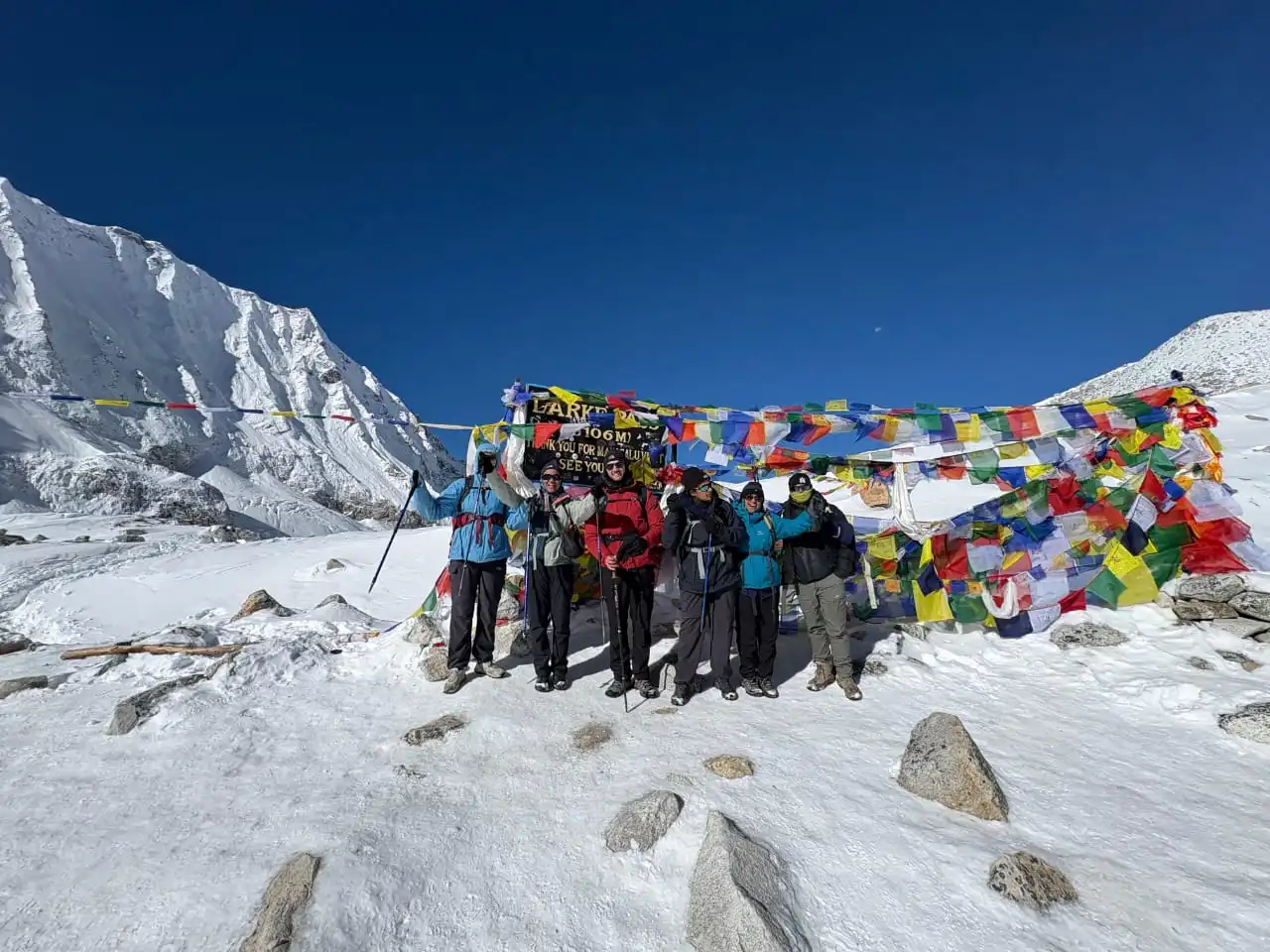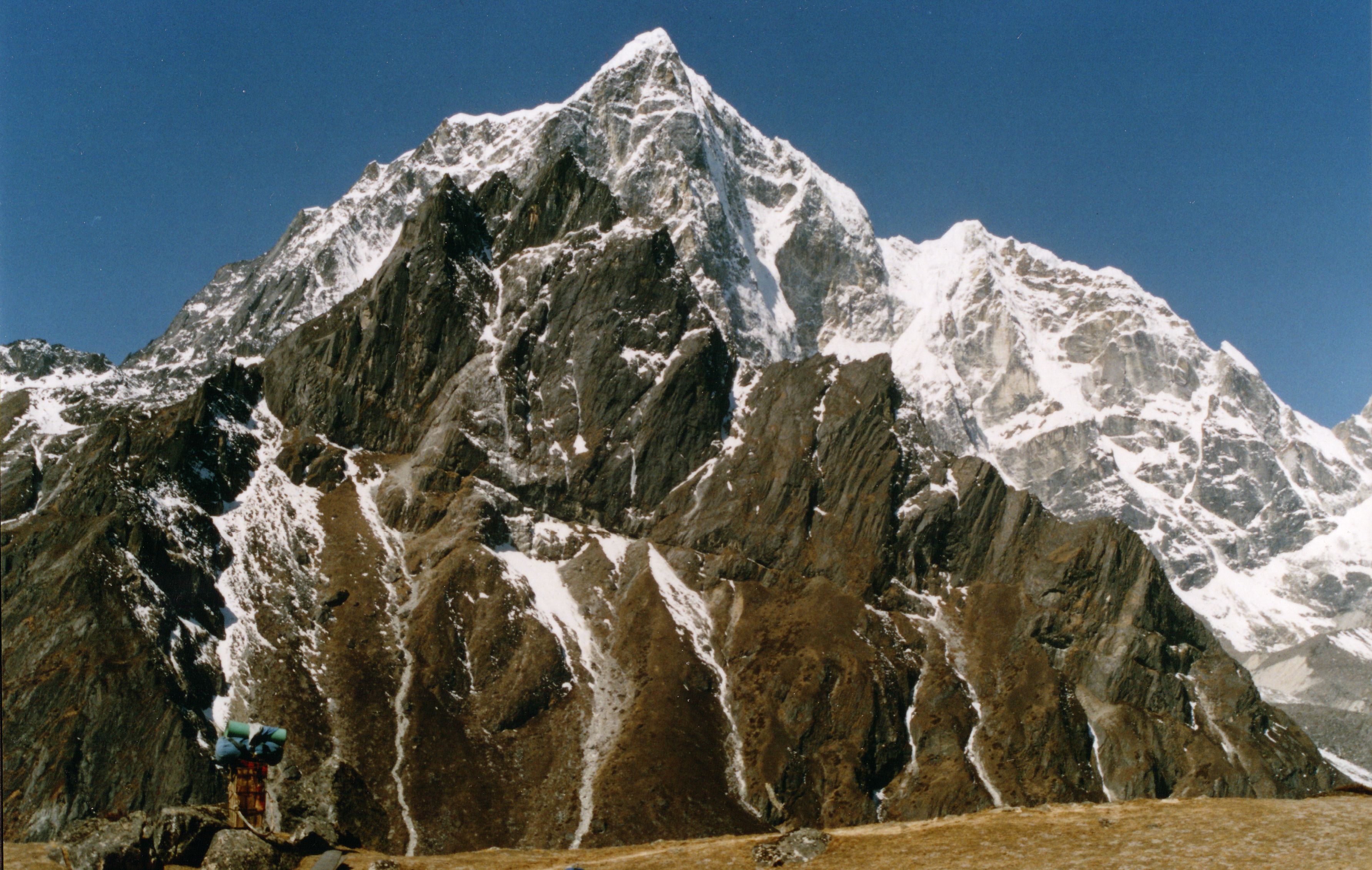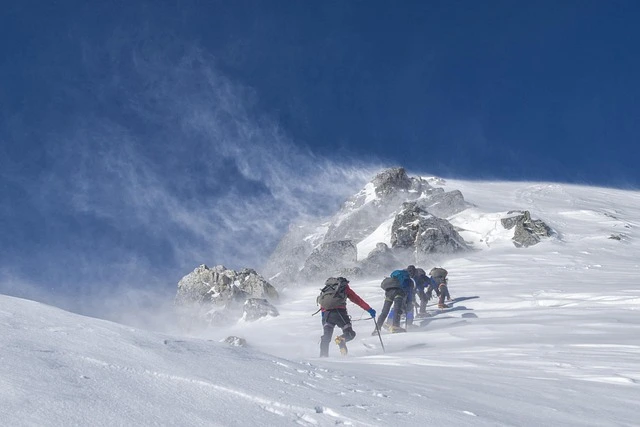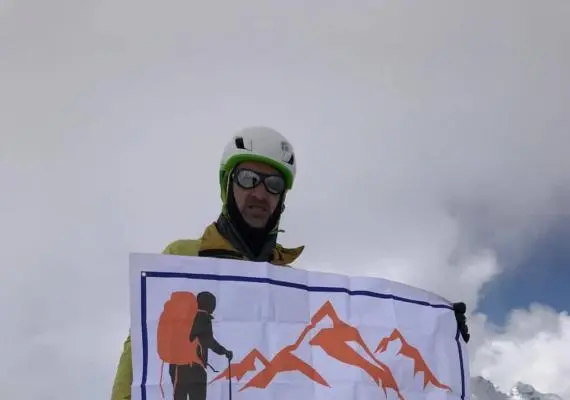The Manaslu Circuit Trek is one of Nepal's best hidden gems, offering real Himalayan adventures away from busy trails.
While Everest and the Annapurna Circuit Trek draw crowds, this journey around the eighth-highest mountain delivers peace, cultural experiences, and stunning views that rival any trek in the Himalayas.
At Himalayan Hero, we've guided adventurers on the Manaslu Circuit Trek for over ten years. Our local knowledge reveals the real spirit of Manaslu trekking—from subtropical fields to Larkya La Pass at 5,106 meters, the trek's highest point.
Unlike commercial routes, the Manaslu Circuit Trek feels untouched. Traditional villages preserve Tibetan culture, while restricted area status protects against overdevelopment, creating authentic experiences with:
- Traditional tea houses with basic comforts
- Genuine cultural experiences in remote villages
- Rare wildlife along the trekking route
- Views of Cheo Himal and Annapurna II
- Ancient Buddhist monasteries
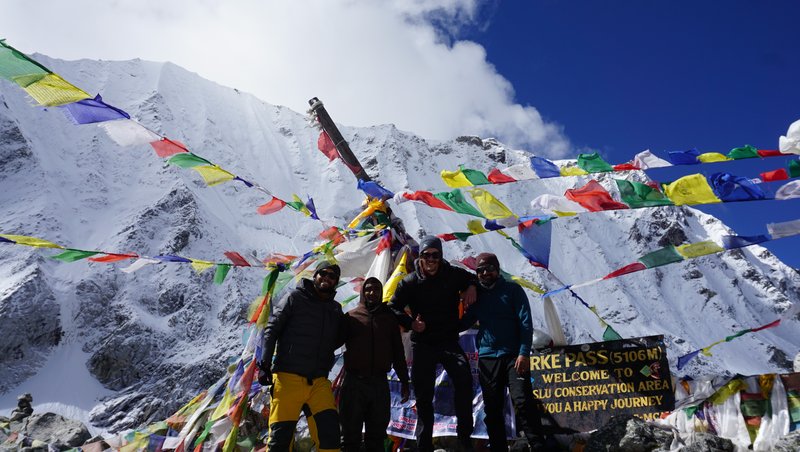
What Makes the Manaslu Circuit Trek Special?
The Manaslu Circuit Trek offers increasingly rare authentic experiences along Nepal's most rewarding trekking route. The trail goes around Manaslu Himal.
It follows the Budhi Gandaki River valley. Then, it crosses the stunning Larke La Pass. This route offers changing views of Manaslu mountain, which is 8,163 meters high.
Cultural Diversity Along the Trail:
- Lower valleys: Hindu communities near terraced fields
- Mid-elevations: Mixed cultural zones
- Higher regions: Strong Tibetan culture influence
- Ancient monasteries offering cultural experiences
- Prayer flags against mountain backdrops
Exceptional Biodiversity: The Manaslu Circuit trek route passes through:
- Six distinct climate zones with varying weather conditions
- Manaslu Conservation Area habitats
- Views of Cheo Himal and surrounding peaks
- Rhododendron forests above the Budhi Gandaki River
- Alpine meadows approaching the highest point
Trail Infrastructure:
- Well-established tea houses throughout
- Basic amenities, including hot showers (for a fee)
- Safe drinking water stations
- Emergency evacuation routes identified
- Connection to the Annapurna Circuit Trek at the trail's end
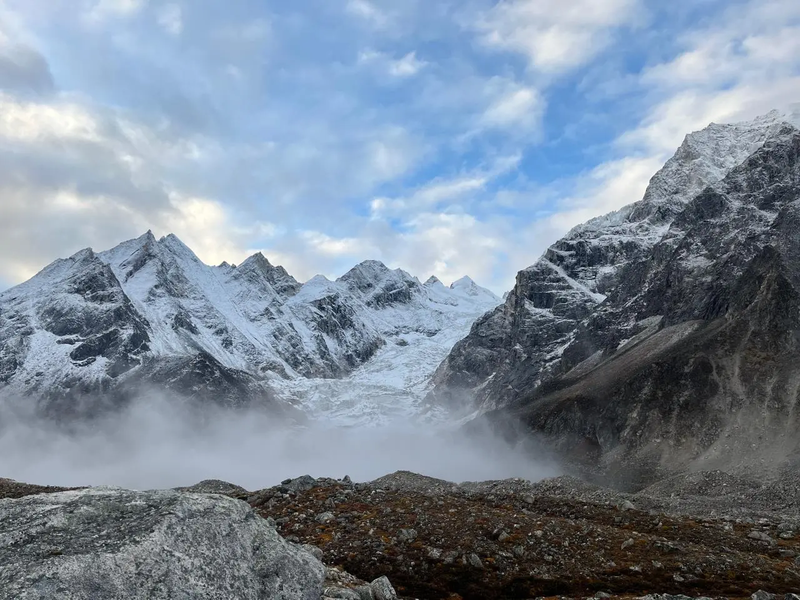
Why Choose the Manaslu Circuit Trek?
The Hidden Gem of Nepal's Himalayas
The Manaslu Circuit Trek offers 177 kilometers of pure Himalayan magic without the crowds. Picture this: you're crossing suspension bridges draped with prayer flags, the turquoise Budhi Gandaki River roaring below, while Ganesh Himal views dominate the horizon. Unlike the busy Annapurna Circuit, you might walk for hours encountering only local shepherds and their flocks.
What makes this restricted trekking permit area special? The limited access preserves both nature and culture. Villages like Samagaon and Samdo feel frozen in time, where traditional Tibetan life continues undisturbed. You'll witness monks performing morning prayers, children in traditional dress playing in stone courtyards, and elderly women spinning prayer wheels that have turned for centuries.
Duration
| Detail |
Information |
| Duration |
12-16 days (14 days standard) |
| Total Distance |
177 km |
| Maximum Altitude |
5,160m (Larkya La Pass) |
| Difficulty |
Moderate to Challenging (7-8/10) |
| Starting Point |
Soti Khola / Machha Khola |
| Ending Point |
Dharapani / Besisahar |
| Best Seasons |
Sep-Nov, Mar-May |
| Sep-Nov, Mar-May |
RAP + MCAP + ACAP ($160-190) |
| Guide Required |
Yes (Mandatory) |
Manaslu Circuit Trek – Itinerary Outline
| Day |
Route |
Max Elevation |
Duration |
| Day 1 |
Drive from Kathmandu to Machha Khola |
930 m / 3,051 ft |
9 hrs |
| Day 2 |
Trek from Machha Khola to Jagat |
1,340 m / 4,396 ft |
6 hrs |
| Day 3 |
Trek from Jagat to Deng |
1,804 m / 5,918 ft |
6 hrs |
| Day 4 |
Trek from Deng to Namrung |
2,630 m / 8,628 ft |
6 hrs |
| Day 5 |
Trek from Namrung to Lho |
2,957 m / 9,701 ft |
4 hrs |
| Day 6 |
Trek from Lho to Samagaun |
3,530 m / 11,581 ft |
4 hrs |
| Day 7 |
Acclimatization Day at Samagaun |
4,400 m / 14,435 ft |
7 hrs |
| Day 8 |
Trek from Samagaun to Samdo |
3,865 m / 12,680 ft |
3 hrs |
| Day 9 |
Trek from Samdo to Dharmasala |
4,460 m / 14,632 ft |
4 hrs |
| Day 10 |
Trek from Dharmasala to Bimthang via Larkya Pass |
3,590 m / 11,778 ft |
10 hrs |
| Day 11 |
Trek from Bimthang to Tilije |
2,300 m / 7,546 ft |
6 hrs |
| Day 12 |
Trek from Tilije to Dharapani |
1,970 m / 6,463 ft |
7 hrs |
| Day 13 |
Drive from Dharapani to Kathmandu |
1,300 m / 4,265 ft |
10 hrs |
Manaslu Circuit Trek Route Map
This Manaslu Circuit Trek map traces the complete route from Kathmandu through key villages to Larkya La Pass (5,160m), the trek's highest point. The circular trail showcases Mt. Manaslu (8,163m), Ganesh Himal, and surrounding peaks, with bus access at start/end points and optional side routes to monasteries.
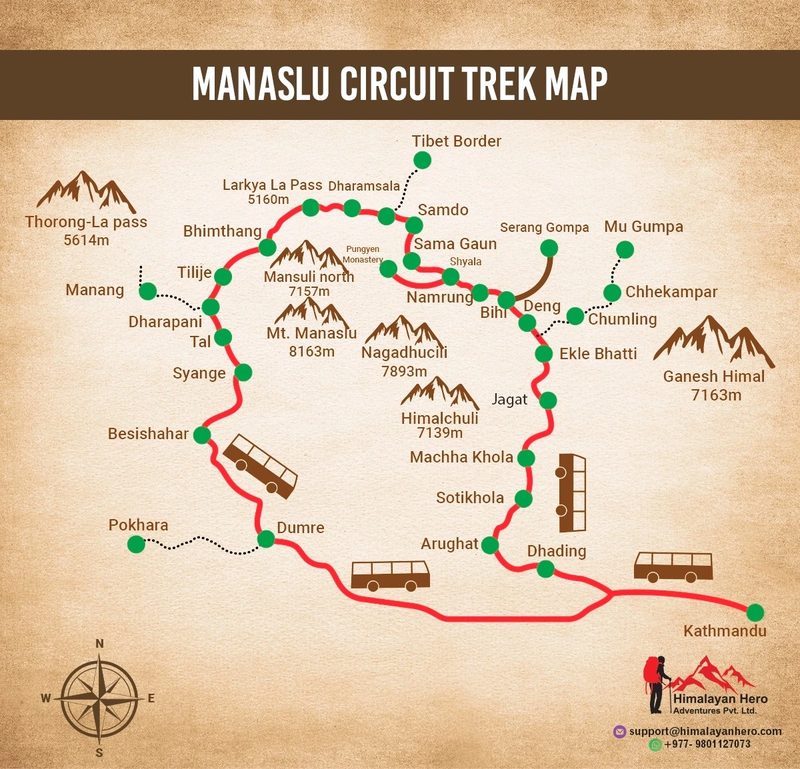
Manaslu Circuit Trek Cost (Updated 2026 Guide)
Understanding the Manaslu Circuit Trek Cost helps proper budget planning. Total expenses for this spectacular trekking route typically range $1,500-$3,000 per person.
Manaslu Circuit Trek Cost
| Expense |
Cost (USD) |
Notes |
| Restricted Area Permit |
$100 (peak) / $75 (off-peak) |
Per 7 days |
| MCAP + ACAP |
$60 |
Combined |
| Licensed Guide |
$25-35/day |
Mandatory |
| Porter |
$20-25/day |
Optional |
| Teahouse |
$5-15/night |
None |
| Meals (3/day) |
$15-35/day |
Varies by altitude |
| Extras |
$5-10/day |
Shower, WiFi, charging |
| Transport |
$50-100 |
Round trip |
| TOTAL |
$1,200-2,000 |
14 days |
Check the full breakdown of the Manaslu cost and itinerary.

Best Time for the Manaslu Circuit Trek
Choosing the Manaslu Circuit trek best time impacts weather conditions, tea house availability, and Larkya La Pass accessibility. Manaslu Circuit Trek 2026 offers two primary seasons along this trekking route.
Autumn Season (September-November): Peak the Manaslu Circuit trek best time features:
- Stable weather conditions post-monsoon
- Clear views of Cheo Himal and Annapurna II
- All tea houses are fully operational
- Hot showers are available in most places
- Larkya La Pass conditions are optimal
Spring Season (March-May): Second-best timing offers:
- Warming weather conditions daily
- Rhododendrons along the Budhi Gandaki River
- Less crowded tea houses
- Drinking water sources flowing well
- Good Annapurna Circuit Trek connections
Winter Considerations:
- Extreme weather conditions at the highest point
- Many tea houses closed
- No hot showers available
- Larkya La Pass often experiences blockages.
- Emergency evacuation risks are higher
Monsoon Challenges:
Manaslu Circuit Trek Map & Route Overview
The Manaslu Circuit trek map shows how this route goes from the Budhi Gandaki River valley to Larkya La Pass. The trail covers approximately 177 kilometers of diverse terrain with strategic tea houses.
Lower Valley Section: The Manaslu Circuit Trek distance begins as follows:
- Budhi Gandaki River northward
- Through terraced fields and villages
- Past numerous hot showers at Tatopani
- Rocky trails gain gradual elevation
- Basic tea houses every few hours
Middle Section Highlights: The trekking route reveals:
- Views of the Cheo Himal massif
- Transition to Tibetan culture zones
- Better-equipped tea house facilities
- Critical acclimatization days locations
- Emergency evacuation helicopter pads
Upper Section Features: Approaching the highest point:
- Distance from Annapurna Circuit Trek
- Limited drinking water sources
- Basic tea houses without hot showers
- Weather conditions are increasingly harsh
- Rocky trails through moraines
Larkya La Pass Crossing: The Larkya La Pass section shows:
- Trek's highest point at 5,106m
- Views toward Annapurna II range
- Critical weather conditions zone
- Emergency evacuation routes marked
- Descent toward Annapurna Circuit Trek
Trek Difficulty, Distance & Fitness Level
The Manaslu Circuit trek is challenging. It has rocky trails and changing weather. The highest point is Larkya La Pass, which tests trekkers' limits. The Manaslu Circuit Trek distance of 177 kilometers requires serious preparation.
Physical Challenges:
- Daily hiking: 6-8 hours on rocky trails
- From terraced fields to glacial moraines
- Weather conditions range from tropical to arctic
- Limited hot showers at altitude
- Scarce drinking water above 4,000m
Altitude Considerations: The Manaslu Circuit trek difficulty intensifies with:
- Larkya La Pass is the highest point
- Mandatory acclimatization days
- 50% oxygen at Trek's highest point
- Emergency evacuation preparedness is crucial
- Weather conditions are affecting oxygen further
Trail Conditions: Throughout this trekking route:
- Rocky trails dominate the upper sections
- Terraced fields give way to moraines
- Budhi Gandaki River crossings are frequent
- Tea house spacing increases with altitude
- Connection to the Annapurna Circuit Trek is well-marked
Required Fitness Level:
- Experience with multi-day trekking route adventures
- Ability to handle changing weather conditions
- Stamina for rocky trails at altitude
- Mental strength when hot showers are unavailable
- Preparation for potential emergency evacuation
Find out if you’re fit enough for the Manaslu Circuit.

Manaslu Trek Permits & Entry Regulations
The Manaslu permit system requires multiple trekking permits due to restricted status. Understanding regulations for this trekking route ensures legal compliance.
Required Trekking Permits: Essential trekking permits include:
Guide Requirements: The Manaslu Circuit trek without a guide is prohibited:
- Registered guide mandatory
- Supports local cultural experiences
- Ensures emergency evacuation capability
- Helps navigate rocky trails safely
- Manages tea house bookings
Permit Checkpoints:
- Jagat: Verify all trekking permits
- Namrung: entering a higher trekking route
- Before Larkya La Pass crossing
- Connection to Annapurna Circuit Trek
- Keep documents waterproof
Why Restrictions Exist:
- Preserve Tibetan culture's authenticity
- Limit impact on terraced fields
- Control tea houses development
- Maintain emergency evacuation infrastructure
- Protect the Budhi Gandaki River ecosystem
Understand Trek permits and regulations.
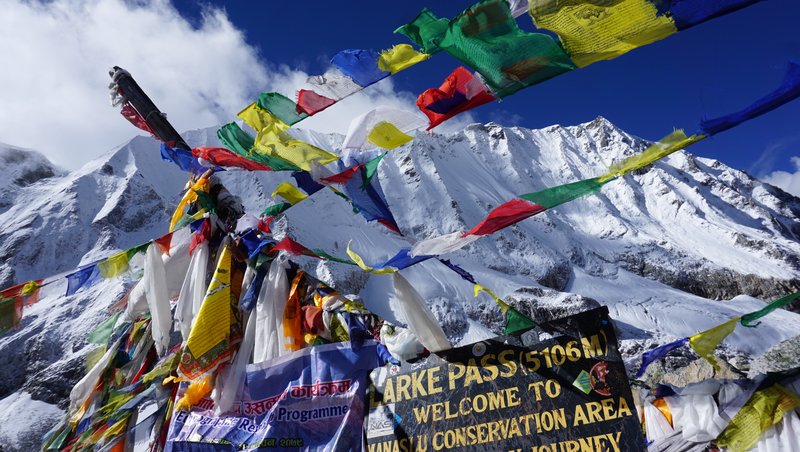
Accommodation and food
Manaslu Circuit trek has a lot of teahouses along the trails that provide lodging too. You will be getting to sleep at the tea houses. The single beds are available. Although it is not always possible to pre-book accommodation, the norm is for your guide to call ahead while you are on the trek or for places with no phone reception. Sometimes the guide will arrange for someone else to go ahead and secure your bed for the night. But most of the tea houses will be there for you to provide your stay for sleeping. Besides, there is wifi and telephone service available.
Meals on Manaslu Circuit Trek
| Meal Type |
Food Options |
| Breakfast |
Bread, Pancakes, Porridge, Eggs, Tea / Coffee |
| Lunch |
Curry items, Chapati, Spaghetti, Daal Bhaat (rice & lentils), Noodles, Mo:Mo (dumplings), Soup |
| Snacks |
Biscuits, Dry fruits, Nuts, Tea / Coffee |
| Dinner |
Daal Bhaat (rice & lentils), Chapati, Dumplings, Curry items |
Food restriction
Non-veg items
See what to expect at Manaslu Circuit trek tea houses.
Alternative Treks Around Manaslu Region
The Manaslu region has many options beyond the classic trekking route. Each option shows a unique view of Tibetan culture and mountain scenery.
Manaslu Base Camp Trek: The Manaslu Base Camp Trek features:
- Same tea houses to Samagaon
- Extensive cultural experiences
- No Larkya La Pass crossing
- More acclimatization days, flexibility
- Lower highest point at 4,800m
Manaslu Base Camp Trekking Advantages:
- Better weather conditions tolerance
- Hot showers are available longer
- The views of Cheo Himal included
- Emergency evacuation easier
- Drinking water is more accessible
Manaslu Tsum Valley Trek: The Manaslu Tsum Valley trek explores:
- Hidden valley with unique Tibetan culture
- A different trekking route entirely
- You need to obtain separate trekking permits.
- Remote tea houses experience
- Rich cultural experiences guaranteed
Combined Adventures: Link with Annapurna Circuit Trek:
- Continue from Larkya La Pass
- Two legendary trekking route options
- Extended acclimatization days benefits
- More terraced fields to glaciers
- Ultimate cultural experiences package
Regional Alternatives:
- Ganesh Himal (fewer trekking permits)
- Everest Base Camp Trek by Road
- Lower highest point options
- Different weather conditions patterns
- Varied tea houses standards
What to Pack for Manaslu Circuit Trek
Manaslu Trek Packing List Essentials
Packing smart means the difference between comfort and misery. Here's your what to pack for the Manaslu Circuit Trek in autumn comprehensive guide:
Clothing Layers
Base Layers:
- 2 thermal tops (merino wool or synthetic)
- 2 thermal bottoms
- 3-4 moisture-wicking t-shirts
- 3-4 pairs of hiking underwear
Insulation Layers:
- Fleece jacket (200-300 weight)
- Down jacket (essential above 4,000m)
- Softshell jacket for wind protection
- Insulated pants for summit day
Outer Layers:
- Waterproof jacket (Gore-Tex or similar)
- Waterproof pants
- Trekking pants (2 pairs)
- Shorts for lower elevations
Footwear and Accessories
Feet:
- Hiking boots (broken in!)
- Camp shoes (Crocs or sandals)
- Trekking socks (5-6 pairs)
- Liner socks for blister prevention
- Gaiters for snow sections
Head and Hands:
- Sun hat with neck protection
- Warm beanie (fleece-lined)
- Buff or neck gaiter (2)
- Sunglasses (UV protection essential)
- Lightweight gloves
- Insulated mittens for summit
Technical Gear
Essential Equipment:
- Sleeping bag (-15°C rated minimum)
- Trekking poles (invaluable for descents)
- Headlamp with extra batteries
- Water bottles or hydration system (3L capacity)
- Water purification tablets/filter
- Daypack (25-35L)
- Duffle bag for porters
Personal Care and Medications
Health Essentials:
- Sunscreen (SPF 50+)
- Lip balm with SPF
- Personal medications
- Altitude sickness pills (Diamox)
- Basic first aid kit
- Toilet paper and a trowel
- Wet wipes and sanitizer
- Feminine hygiene products
Electronics and Documents
Don't Forget:
- Camera with extra batteries
- Power bank (solar optional)
- Universal adapter
- Passport and permits copies
- Travel insurance documents
- Emergency contact information
- Cash in small denominations
Don’t miss the ultimate Manaslu packing list.
Tips for a Successful Manaslu Circuit Trek
Tea-house vs tent camping:
Stick to tea-houses. They offer meals, warm beds, and a cultural experience that makes trekking easier and more immersive. Tents are unnecessary unless you’re off-season or doing a remote route.
Altitude acclimatization at Samagaun:
Take a rest day here. It helps your body adjust to the elevation before crossing Larkya La Pass. Consider a short hike to Birendra Lake or Pungyen Monastery.
Gurung and Tibetan villages, plus wildlife:
The trail passes through authentic Gurung and Tibetan communities like Lho and Samdo. Keep an eye out for blue sheep and Himalayan marmots, especially at higher altitudes.
Packing list essentials for Manaslu Circuit trek:
Bring layered clothing, a sleeping bag (rated to -10°C), hiking boots, headlamp, water bottle, sunscreen, microspikes, and a small first aid kit. Keep your daypack light.
Hydration and food: Drink plenty of water (3–4 liters daily). Dal Bhat is the most filling and reliable meal, but you’ll also find pancakes, pasta, and tea at most teahouses.
Fitness preparation:
Train with cardio and light strength workouts before the trek. Aim to walk several miles a week with a loaded backpack to build endurance.
Permits and guides:
The Manaslu region is restricted, and a licensed guide is mandatory. They assist with permits, safety, and navigating unfamiliar terrain.
Money and charging:
Bring enough cash in Nepali rupees. ATMs are only available in Kathmandu. Charging devices can cost 200–500 NPR at higher elevations.
Insurance coverage:
Make sure your travel insurance includes high-altitude trekking and emergency helicopter evacuation up to 6,000 meters.
Best seasons: Trek in spring (March–May) or autumn (September–November) for clear skies and optimal conditions. Avoid the monsoon and mid-winter months for safety and comfort.
Discover the best time to trek for clear mountain views.
Highlights and Experiences on the Manaslu Circuit Trek
- Mount Manaslu (5,163 metres), the 8th highest mountain in the world
- Crossing the Larkya La Pass (5,106 metres)
- Tsum valley (optional)can make you feel like taking a step off the beaten path
- Immersing into the tapestry of authentic Gurung and Tibetan village life
- Serang Monastery to observe the daily rhythm of monks and school children against the backdrop of breathtaking mountains
- Pungyen Monastery and Nubri Monastery
- Mani walls and Birendra lake along with the suspension bridges
- Crossing the border of Nepal and Tibet
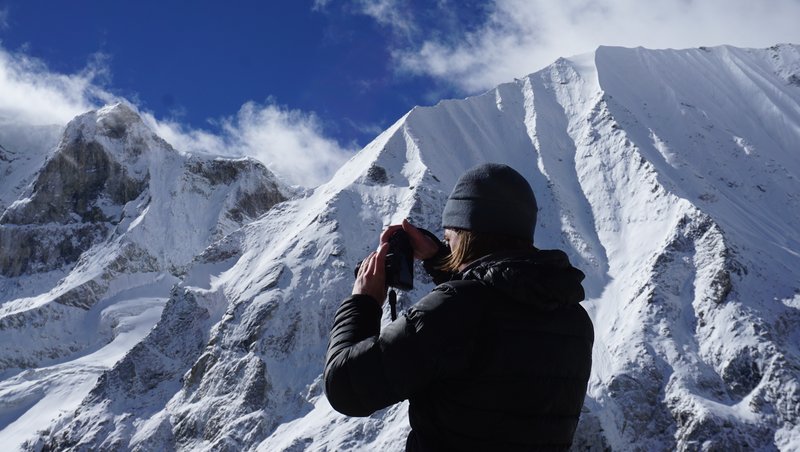
Manaslu Circuit Trek vs Everest Base Camp Trek (Pros & Cons)
| Comparison Factor |
Everest Base Camp Trek |
Manaslu Circuit Trek |
| Popularity |
One of the world’s most famous treks |
Less known and far less crowded |
| Crowd Level |
Very crowded during peak seasons |
Quiet and peaceful |
| Scenery |
Views of Mt. Everest, Ama Dablam, Khumbu Icefall |
Diverse landscapes, valleys, glaciers, Larkya La Pass |
| Cultural Experience |
Sherpa culture and monasteries |
Gurung, Tamang & Tibetan cultural immersion |
| Trek Duration |
12–14 days |
14–18+ days |
| Difficulty Level |
Moderate (suitable for fit beginners) |
Moderately difficult to challenging |
| Highest Point |
Kala Patthar (5,545 m) |
Larkya La Pass (5,160 m) |
| Guide Requirement |
Guide optional |
Licensed guide mandatory |
| Permits |
Standard permits (Sagarmatha NP, TIMS) |
Special restricted-area permits required |
| Best For |
First-time Himalayan trekkers |
Experienced trekkers seeking solitude |
Why Choose Himalayan Hero for Your Manaslu Circuit Trek
Himalayan Hero specializes in authentic Manaslu Circuit Trek experiences, maximizing cultural experiences while ensuring safety on this challenging trekking route.
Our Local Expertise:
- 10+ years on this trekking route
- Deep Tibetan culture connections
- Best tea houses relationships
- Weather conditions expertise
- Emergency evacuation protocols established
Safety Standards:
- Monitor Larkya La Pass conditions
- Track weather conditions constantly
- Emergency evacuation insurance included
- Drinking water purification provided
- The authorities strictly enforce acclimatization days.
Cultural Commitment: Your Manaslu Circuit Trek supports:
- Local tea houses directly
- Tibetan culture preservation
- Terraced fields communities
- Budhi Gandaki River conservation
- Authentic cultural experiences
Practical Advantages:
- Arrange all trekking permits
- Book best tea houses ahead
- Guarantee hot showers where available
- Provide drinking water purification
- Include local bus arrangements
Trek Enhancements:
- Photography at the highest point
- Cheo Himal viewpoint detours
- Annapurna II sunrise spots
- Extra acclimatization days if needed
- Flexible weather conditions scheduling
📧 Email: [email protected]
📱 WhatsApp: +977-9801127073
🌐 Website: himalayanhero.com
Conclusion
The Manaslu Circuit Trek delivers Nepal's most authentic mountain experience. From terraced fields along the Budhi Gandaki River to the summit of Larkya La Pass, this trekking route offers challenges and rewards that transform every trekker.
What Makes It Unforgettable:
- Conquering Larkya La Pass at 5,160m
- Immersing in authentic Tibetan culture
- Views of Cheo Himal and Annapurna II
- Traditional tea houses with genuine hospitality
- Remote villages untouched by mass tourism
Success requires proper acclimatization days, respect for weather conditions, and quality trekking permits. Unlike busier routes like the Annapurna Circuit Trek, the Manaslu Circuit Trek preserves its pristine character and cultural authenticity.
Himalayan Hero ensures your Manaslu Circuit Trek balances adventure with safety. Our sustainable approach protects this ancient trekking route for future generations while maximizing your cultural experiences.
This isn't just another trek—it's a journey through one of Earth's last untouched Himalayan landscapes, where drinking water flows from mountain streams and emergency evacuation helicopters remain the only modern presence.
Ready for your transformation? The Manaslu Circuit Trek 2026 awaits.

